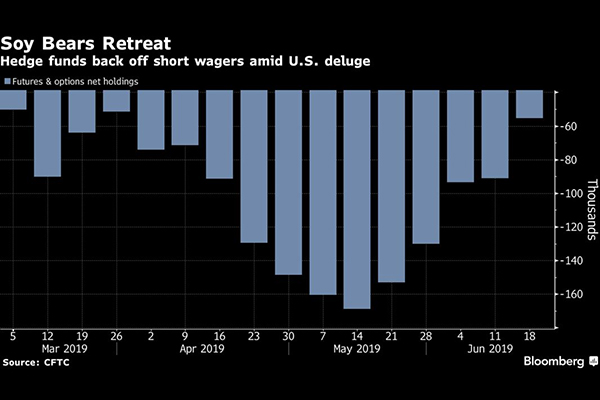Soybeans May Be Next Market to Surge as Wet Weather Drags On

Corn prices have been on an epic run. Now, soybeans could soon be catching up.
With more rain forecast for the U.S. Midwest, oilseed plantings are under threat and hedge funds are backing away from their bearish wagers. Meanwhile, corn is heading for its best quarterly advance since 2010, and the funds are betting there’s more room to run, raising their net-bullish holdings to the highest in a year.
Fields are still flooded, keeping farmers from seeding and threatening yields. Cooler and wetter-than-normal weather remains in the forecast. The U.S. Department of Agriculture will update its plantings estimate June 28, but analysts and traders already are concerned the agency’s numbers will be too high and not fully reflect the impact of the deluge.
“Most people would suggest this survey is a little dated,” said Rich Nelson, chief strategist at Allendale Inc. in McHenry, Ill., referring to the USDA report.
In the weeks and months ahead, the agency likely will have to take down estimates both for U.S. soy acreage and yield to reflect major planting delays, Nelson said. That could boost soybeans prices that lagged behind corn’s big run. Most-active rolling futures are heading for a gain of less than 6% this quarter, while the grain has surged about 28%.

As of June 18, investors slashed their soy net-short position by 39% from a week earlier to 55,307 futures and options, U.S. Commodity Futures Trading Commission data showed June 21. The figure, which measures the gap between bets on a price increase and on a decline, is the smallest since late March. (Bloomberg News)
Soybeans have trailed for a reason. In the United States, the oilseed can be planted later in the spring than corn. Amid the heavy rains, some analysts had forecast that the weather eventually would clear, and farmers would plant more soy. That would have meant bigger production at a time when demand already is suffering amid the U.S.-China trade war.
But with more showers in the forecast, that scenario is becoming less likely.
“After the corn problem was realized, everyone started shifting their focus to beans,” said Terry Reilly, senior commodity analyst at Futures International in Chicago.
As of June 18, investors slashed their soy net-short position by 39% from a week earlier to 55,307 futures and options, U.S. Commodity Futures Trading Commission data showed June 21. The figure, which measures the gap between bets on a price increase and on a decline, is the smallest since late March.
In corn, money managers raised their net-long position by 29% to 143,515 contracts. That’s the highest since May 2018.
For soybeans, the trade outlook also will loom large. Donald Trump and China’s Xi Jinping are expected to meet on the sidelines at the Group of 20 summit held in Japan starting June 28. Any signs of an easing in tensions also could spark a move higher in prices. China is the world’s top soy importer.
Meanwhile, grain trading houses are positioning for a prolonged impact from the U.S. rains. Cargill Inc. said it has initiated flood mitigation plans for grain facilities along the Mississippi and Illinois rivers.
“The impacts of the flooding and other events will continue through the 2019 growing season into harvest,” Cargill spokeswoman April Nelson said in a statement June 21.




